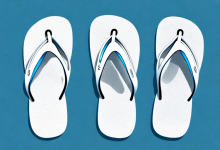No matter if you’re a short day-hiker or a seasoned wilderness traveler, you need the right gear for any outdoor activity. But when it comes to selecting outdoor footwear, it can be tricky to find the perfect fit. Hiking sandals represent an attractive middle ground between full-fledged hiking boots and more casual footwear. But without the right sizing and a quality design, you won’t get maximum functionality and comfort. Let’s take a look at what to look for when buying hiking sandals and how to measure your feet to find the ideal fit.
What to Look for When Buying Hiking Sandals
When selecting a pair of hiking sandals, there are several features that you should consider. To start, a good hiking sandal should have strategically placed straps to provide support and prevent your foot from sliding around in your sandal. Additionally, proper arch support is key for all day comfort. Make sure that your hiking sandals have contoured footbeds that hug the shape of your feet. While weight will vary from model to model, keep in mind that any extra ounces on your feet will add up – so if you’re looking for light, fast gear, opt for a model that’s intentionally lightweight. Finally, most quality sandals will have internal cushioning and shock absorption to help reduce fatigue and joint pain on the trail.
How to Measure Your Foot for the Right Size
The best way to get the perfect fit when purchasing hiking sandals is to measure your foot at home. All you need is a ruler or measuring tape and it should only take a minute. Start by removing any socks or tights that you usually wear with a regular pair of shoes – this will help you get an accurate measurement. On a hard flat surface, gently press down on your heel with one foot while measuring from the tip of your longest toe to your heel with the other. Do this twice to double check your measurements and then note down the numbers. It’s recommended to add ½-1 cm of space to your measurements to allow for foot swell during long hikes.
Tips for Finding the Perfect Fit
As a general rule, make sure that your sandal has room for your longest toe (as measured above) and slightly more space around your first and second toes. If your sandal feels too tight, or if you can feel any parts of the straps rubbing against your skin when walking, it’s too small – try the next size up. Furthermore, if you find that your sandal seems too wide and your foot slides around inside it too much, try a more snug size and/or an adjustable strap configuration rather than a loose one.
Why Properly Fitting Hiking Sandals Are Important
It’s essential that all outdoor gear fits properly since it can directly affect how well you hike. An uncomfortable fit can cause irritation and pain while walking, which can easily spoil an otherwise good hike! By opting for hiking sandals with an exact fit, your feet will be supported better, resulting in less fatigue, fewer blisters and fewer muscle aches.
Different Types of Hiking Sandals and Their Benefits
When searching for the perfect pair of hiking sandals, there are many styles available. Depending on the type of terrain and activities you plan on doing, certain styles may be more appropriate than others. For instance, closed-toe sandals are great for rocky trails since they offer more protection while also supporting your foot and providing traction on slippery surfaces. Open-toe sandals are more breathable but offer less support. A combination of both designs is ideal for more moderate terrain.
Pros and Cons of Synthetic vs Leather Hiking Sandals
Hiking sandals come in a variety of materials – from synthetic fabrics to genuine leather. Each material has its own set of pros and cons. Synthetic fabrics are typically less expensive than their leather counterparts but require more maintenance since they don’t have the water resistance that leather provides. Leather hiking sandals are more expensive but also much more durable and water repellant.
How to Care for Your Hiking Sandals
To keep your hiking sandals comfortable and looking like new, it’s important to follow some basics steps when it comes to cleaning them. If you plan on wearing them in wet conditions, make sure to spray them with waterproofing spray in advance. After each hike, simply use a damp cloth to wipe down the uppers and remove any dirt or grime. Let them air-dry after each hike and make sure to lubricate the buckles frequently.
Popular Brands of Hiking Sandals
When looking for quality hiking sandals, there are multiple brands available on the market. Popular manufacturers like Teva, Keen, Merrell and Chaco make high-performing sandals that are built to last. All of these brands offer a range of sizes and styles for any activity level so make sure to check out their collections for some inspiration.
Where to Buy Quality Hiking Sandals
Amazon, Backcountry, Eureka Online, REI, Sierra Trading Post, and Zappos are just a few retailers that carry quality hiking sandals from major brands. Do some online shopping to browse different models, compare prices and check reviews before selecting the perfect pair.



